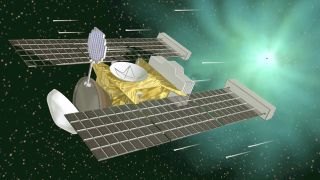Sounds in space: What noises do planets make?
From Martian winds to Saturn’s aurora, how sounds in space add to our understanding of the universe.

In 2022, people on Earth were able to hear the planetary sounds of Mars thanks to two microphones installed on board NASA's Perseverance rover. The audio clips of these sounds in space captured range from a gust of Martian wind to the snapping sound of the rover’s laser hitting a rock.
According to NASA, these sounds are subtly different from what you would hear on Earth, being quieter and more muffled due to the lower density and different composition of the Martian atmosphere. Even so, anyone expecting other planets to sound truly "alien" might be disappointed by just how ordinary Perseverance's recordings sound.
But there are other possibilities. The planetary sounds we hear, are wavelike vibrations of air molecules occurring within the range of frequencies to which our ears are sensitive, according to the BBC .
However, it's possible to process any other kind of wave or oscillation electronically, scaling it to audible frequencies and then converting it into a sound wave. This can be done with virtually any type of astronomical data, often with distinctly spooky results. The process of turning non-acoustic data into audible sounds — called sonification — can have benefits for astronomers involved in analyzing the data, according to Scientific American.
One of the best known examples came from the European Space Agency (ESA)'s Rosetta mission to comet 67P/Churyumov–Gerasimenko. This particular sonification, released during the encounter in Nov. 2014, was based on low-frequency oscillations in the comet's magnetic field, which were then scaled up by a factor of 10,000 to make them audible, according to ESA .
Called "The Singing Comet" and heard over 5 million times, this was one of the first pure audio clips to go viral when it was posted on SoundCloud, according to National Public Radio.

Another promising source of outer space "sound" is radio astronomy. One of the first uses of radio here on Earth was for sound broadcasting, and just as an audio signal can be carried by a radio wave, so radio telescope data can be transformed into audible sounds. One of the pioneers of "acoustic astronomy" is Fiorella Terenzi, who used it initially as an aid to data analysis, and later as a form of science outreach.
According to Popular Mechanics , Terenzi began converting radio waves from distant galaxies into audio form when she was a student in 1987. Now a professor at Florida International University, Terenzi has applied similar techniques to other astronomical data, including radio emissions from the planets Jupiter and Saturn and the Earth's own magnetosphere. A selection of audio clips can be heard on her website .
While ground-based radio telescopes listen in on signals originating vast distances away, sensors fitted to interplanetary spacecraft can "hear" radio waves — and other types of signal — in situ. Here we take a brief look at some of the otherworldly sounds that have been recorded.
Sounds of Earth's magnetosphere
Sounds of Jupiter and Saturn
When NASA's Juno spacecraft crossed the boundary between interplanetary space and Jupiter’s magnetosphere in 2016, there was an abrupt change in the electric field measurements it recorded, according to NASA. In a YouTube video from NASA’s Jet Propulsion Laboratory, these measurements were converted into sound waves, which brought out the dramatic nature of the change much more vividly than a conventional graphical representation.
More than a decade earlier, NASA released another striking audio clip, in this case made by the Cassini probe to Saturn. This eerie recording, displaying an amazing range of variations in both frequency and time, is derived from the planet’s radio emissions. These are closely related to Saturn's aurora, which, like the Earth’s, occur around the poles of the planet.
Landers with microphones
When NASA’s Perseverance rover picked up the sounds of Mars in Feb. 2021, it was the first to do so – but only just. Soon after, China released audio recordings made by its own Mars rover, Zhurong, Space.com reported at the time. Now we have a good idea what the Red Planet sounds like – but what about other places that have atmospheres thick enough to carry sound waves?
The Soviet Union’s Venera 13, which landed on Venus in March 1982, was the first spacecraft to record sounds on another planet. These include both the Venusian wind and the sound of the probe itself hitting the ground. Later, the European Space Agency’s Huygens lander carried a microphone on its descent through the atmosphere of Saturn’s moon Titan.

Sounds of a comet encounter
The electromagnetic sounds recorded by Rosetta on its cometary encounter required considerable processing to make them audible to human ears. But when an earlier probe, NASA's Stardust, flew past comet Tempel 1 in 2011, it "heard" something much closer to real sounds.
While sound waves can't travel through space, dust grains and larger debris breaking off the comet could be heard when they hit the probe’s protective shield. According to NASA, around 5,000 impacts were detected over an 11 minute period as the spacecraft was pelted by fragments of dust and ice.
Additional resources
You can listen to a selection of sounds recorded in space, including the song of the sun and Cassini-Huygens passing through Saturn's rings, at ESA's website. Find out how musician Mickey Hart produced music using frequencies from space in this article from Smithsonian.
Bibliography
- "Heavenly Sounds: Hearing Astronomical Data Can Lead to Scientific Insights". Scientific American (2014).
- Terenzi, F. "Acoustic Astronomy: The Sounds of the Universe, Audiofication/Sonification of Celestial Data". Florida International University.
- Mössinger, J.C. "Sounds from space". Nature (2003).
- "The interaction between the solar wind and the Earth's magnetosphere". The Journal of Geophysical Research (1962).
Join our Space Forums to keep talking space on the latest missions, night sky and more! And if you have a news tip, correction or comment, let us know at: community@space.com.
Get the Space.com Newsletter
Breaking space news, the latest updates on rocket launches, skywatching events and more!

Andrew May holds a Ph.D. in astrophysics from Manchester University, U.K. For 30 years, he worked in the academic, government and private sectors, before becoming a science writer where he has written for Fortean Times, How It Works, All About Space, BBC Science Focus, among others. He has also written a selection of books including Cosmic Impact and Astrobiology: The Search for Life Elsewhere in the Universe, published by Icon Books.
